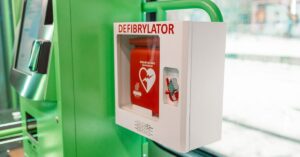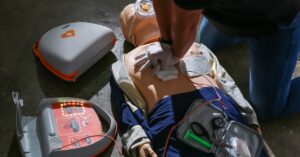
Face masks have become part of the new normal uniform in America following the Centers for Disease Control and Prevention’s recommendation that people wear them in public. But simply wearing one doesn’t necessarily mean you’re protected ― or protecting anyone else.
Masks are meant to help prevent you from accidentally spreading or catching an infectious disease that, like COVID-19, is believed to primarily spread through respiratory droplets. Since 25% of people infected with the novel coronavirus may not be experiencing symptoms, according to an estimate from CDC director Dr. Robert Redfield, everyone is encouraged to wear masks to protect others while in public.
“We know that there are people that are asymptomatic that could spread the virus before they have symptoms. I think we need to work under the concept that anyone you run into could potentially infect you,” said Thomas Russo, the chief of the infectious disease division at the University of Buffalo. “That is the ugly reality of this epidemic.”
To help stop the spread of COVID-19, you need to put on your mask the right way and avoid making these simple yet consequential mistakes:
MISTAKE 1: Your face mask only covers your mouth.
If you are wearing your mask low so it only covers your mouth, you’re doing it wrong, and you risk becoming ill or making someone else ill.
“We often breathe partially or completely through our nose, and you can [become infected] by breathing viral particles,” Russo said. “Likewise, if you’re infected and your mask is down just covering your mouth, if you sneeze … then you can generate respiratory droplets in that fashion.”
If your nose is not covered by the mask, you also risk contamination from the mask itself, which collects germs and droplets on its exterior.
“If the nostrils are peeking out above the mask and the external edge of the mask is rubbing against the nostrils, cross-contamination could occur from the mask to the nose,” said Lucy Wilson, the chair of the department of emergency health services at the University of Maryland, Baltimore County.
MISTAKE 2: Your mask comes in contact with your body or your stuff.
Do not touch the front of your mask with your hands after using one, because the front of the mask could be contaminated.
If the coronavirus gets on your clothes, face or body, and your loose mask touches those things, that’s a problem, too.
“Concern for improperly wearing a mask is based on the risk of contamination,” Wilson said. “If the inside of the mask touches another part of the body that is contaminated with the virus ― hair, forehead, chin, neck, hands, other clothing ― then the inside of the mask is returned to the nose and mouth area [where there are] vulnerable mucous membranes, infection can occur.”
And don’t leave it resting on your neck when not on your face.
“It’s better for the mask not to be around your neck if you’ve already been wearing it, because then if there was any type of contamination, you don’t want [to be] wearing that around your neck,” said Erin Sorrell, an assistant research professor in Georgetown University’s department of microbiology and immunology. “The whole purpose of the face mask is to protect your nose and mouth from your own coughs and sneezes and protecting others, or protecting you from large spills or large droplets.”
To properly put on and take off a mask, you also need to be careful not to touch the front of the mask when removing it, the CDC warns. Instead of touching the mask itself, remove the mask by holding the ear loops or ties. Once it’s off, you can put the face mask in a ziplock bag or separate containment area, Sorrell said. “The idea is then you’re preventing it from contaminating other surfaces and you’re not playing around with it as it hangs around your neck.”
Remember to wash your hands before and after you put a face mask on or take it off, medical experts advise.
MISTAKE 3: Your mask hangs too loosely on your face.
When worn properly, N95 respirators that doctors use are closely fitted to the face. But if you are using a surgical mask or a homemade cloth mask, you may be letting the sides gap loosely.
You don’t want the mask to billow out this way. Sorrell said the goal is to create a barrier that blocks out as much air as possible. “You are not going to get a perfect seal with a surgical mask or with a homemade mask, but you want to make sure it fits properly,” Sorrell said. “It needs to be comfortable so that you’ll wear it, but secure enough that it doesn’t slide down.”
“With surgical masks, there tends to be a little bit of gap on the sides,” Russo said. “People need to do the best they can to tighten up that space with the straps.”
Russo also noted that beards can prevent masks from fitting closely, and recommended that people with them at least trim their beards close to their faces. “The bigger, the fluffier the beard is, the mask is going to lose its optimal functionality as well,” he said.
MISTAKE 4: Your face mask covers only the tip of your nose.
It’s key to put your mask on the bridge of your nose, not at the end of it, so that you can create the best seal you can with the mask you have.
“If you [are covering] just the tip of your nose, that’s going to leave big air gaps on the top of your mask for air to be able to come in and out,” Sorrell said. “That’s why we recommend that the mask sits on the bridge of your nose and not the tip.”
MISTAKE 5: You don’t properly clean your mask if you reuse it.
If you’re planning to reuse your mask, you need to make sure it does not become one more contamination zone. The CDC says you can wash homemade fabric masks in a washing machine.
“I would wash them every day,” Sorrell said. “Then you’re at least making sure that your mask is clean on a daily basis.”
Medical experts have previously told HuffPost that disposable N95 masks can also be steamed over a pot of boiling water for 10 minutes, but need to be dry before use.
Once a mask is visibly soiled or damaged, safely dispose of it.
Experts are still learning about the novel coronavirus. The information in this story is what was known or available as of press time, but it’s possible guidance around COVID-19 could change as scientists discover more about the virus. Please check the Centers for Disease Control and Prevention for the most updated recommendations.
Article Source – Huffpost







